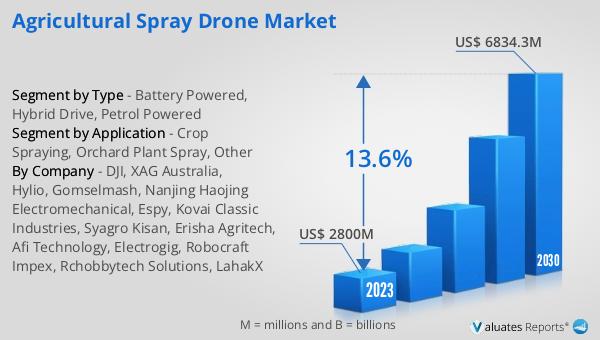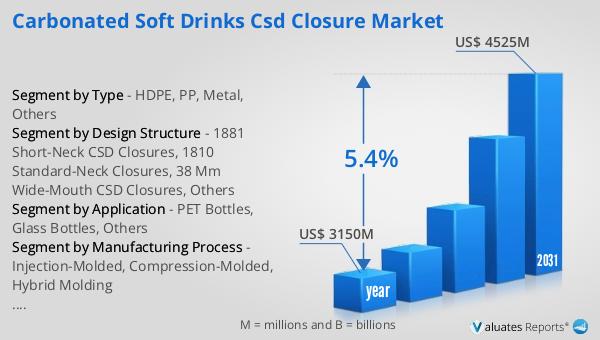What is Global Agricultural Spray Drone Market?
The Global Agricultural Spray Drone Market refers to the industry focused on the development, production, and sale of drones specifically designed for agricultural applications, particularly for spraying crops. These drones are equipped with advanced technologies such as GPS, sensors, and automated systems to efficiently and accurately apply fertilizers, pesticides, and herbicides to crops. The use of agricultural spray drones offers numerous benefits, including increased precision in application, reduced labor costs, and minimized environmental impact due to targeted spraying. This market is driven by the growing demand for sustainable farming practices, the need to increase agricultural productivity, and the rising adoption of advanced technologies in agriculture. As farmers and agricultural businesses seek more efficient and effective ways to manage their crops, the demand for agricultural spray drones continues to grow, making it a significant segment within the broader agricultural technology market.

Battery Powered, Hybrid Drive, Petrol Powered in the Global Agricultural Spray Drone Market:
In the Global Agricultural Spray Drone Market, there are three main types of power sources for these drones: battery-powered, hybrid drive, and petrol-powered. Battery-powered drones are the most common type, primarily due to their environmental benefits and lower operational costs. These drones use rechargeable lithium-ion batteries, which provide a clean and quiet operation. They are ideal for small to medium-sized farms and can typically operate for 20 to 30 minutes on a single charge, depending on the battery capacity and the weight of the payload. The main advantage of battery-powered drones is their low maintenance requirements and the absence of emissions, making them an eco-friendly option. However, their limited flight time and the need for frequent recharging can be a drawback for larger agricultural operations. Hybrid drive drones combine the benefits of both battery and petrol-powered systems. These drones use a combination of a small internal combustion engine and an electric motor, which allows them to achieve longer flight times and carry heavier payloads compared to battery-powered drones. The internal combustion engine generates electricity to recharge the batteries during flight, extending the operational time significantly. Hybrid drive drones are suitable for larger farms and more extensive spraying tasks, as they can cover more ground without the need for frequent refueling or recharging. The main advantage of hybrid drive drones is their extended flight time and increased payload capacity, making them a versatile option for various agricultural applications. However, they are more complex and expensive to maintain compared to battery-powered drones. Petrol-powered drones are equipped with internal combustion engines that run on gasoline or other types of fuel. These drones offer the longest flight times and the highest payload capacities, making them ideal for large-scale agricultural operations. Petrol-powered drones can operate for several hours on a single tank of fuel, allowing them to cover vast areas without the need for frequent refueling. They are particularly useful for spraying large fields, orchards, and plantations where extended flight times and heavy payloads are required. The main advantage of petrol-powered drones is their ability to handle large-scale spraying tasks efficiently. However, they produce emissions and noise, which can be a concern for environmentally conscious farmers. Additionally, petrol-powered drones require more maintenance and have higher operational costs compared to battery-powered and hybrid drive drones. Each type of power source for agricultural spray drones has its own set of advantages and disadvantages, making them suitable for different types of agricultural operations. Battery-powered drones are ideal for small to medium-sized farms with a focus on sustainability and low operational costs. Hybrid drive drones offer a balance between flight time and payload capacity, making them suitable for larger farms and more extensive spraying tasks. Petrol-powered drones provide the longest flight times and highest payload capacities, making them the best choice for large-scale agricultural operations. As the Global Agricultural Spray Drone Market continues to grow, advancements in technology and improvements in battery efficiency, hybrid systems, and internal combustion engines are expected to further enhance the capabilities and performance of these drones, making them an increasingly valuable tool for modern agriculture.
Crop Spraying, Orchard Plant Spray, Other in the Global Agricultural Spray Drone Market:
The usage of agricultural spray drones in crop spraying has revolutionized the way farmers manage their fields. These drones are equipped with advanced GPS and sensor technologies that allow for precise application of fertilizers, pesticides, and herbicides. By using drones, farmers can target specific areas of their fields that require treatment, reducing the amount of chemicals used and minimizing environmental impact. This precision spraying also helps in reducing the risk of over-application, which can harm crops and soil health. Additionally, drones can cover large areas quickly and efficiently, saving time and labor costs. The ability to access hard-to-reach areas and spray crops uniformly ensures better crop health and higher yields. Overall, the use of agricultural spray drones in crop spraying enhances productivity, sustainability, and profitability for farmers. In orchard plant spraying, agricultural spray drones offer significant advantages over traditional methods. Orchards often have dense foliage and uneven terrain, making it challenging to spray trees uniformly using ground-based equipment. Drones can easily navigate through the orchard, reaching the tops of trees and ensuring even coverage of the entire plant. This is particularly important for fruit trees, where pests and diseases can affect the quality and yield of the produce. By using drones, orchard owners can achieve better pest and disease control, leading to healthier trees and higher-quality fruits. Additionally, drones can operate in various weather conditions and can be programmed to spray at optimal times, such as early morning or late evening, when wind speeds are lower, reducing the risk of drift and ensuring more effective application. Apart from crop and orchard plant spraying, agricultural spray drones are also used in other areas such as weed control, nutrient application, and irrigation management. For weed control, drones can be equipped with specialized sensors to identify weed-infested areas and apply herbicides precisely, reducing the need for blanket spraying and minimizing chemical usage. In nutrient application, drones can deliver foliar fertilizers directly to the plants, ensuring that nutrients are absorbed quickly and efficiently. This targeted approach helps in addressing nutrient deficiencies and promoting healthy plant growth. In irrigation management, drones can be used to monitor soil moisture levels and identify areas that require additional watering. By using drones for these tasks, farmers can optimize resource usage, reduce costs, and improve overall farm management. The versatility and efficiency of agricultural spray drones make them an invaluable tool for modern farming practices. Whether it is crop spraying, orchard plant spraying, or other agricultural applications, these drones offer numerous benefits that enhance productivity, sustainability, and profitability. As technology continues to advance, the capabilities of agricultural spray drones are expected to improve further, making them an essential component of precision agriculture. Farmers and agricultural businesses that adopt these innovative tools can stay ahead of the curve, ensuring better crop health, higher yields, and more sustainable farming practices.
Global Agricultural Spray Drone Market Outlook:
The global Agricultural Spray Drone market was valued at US$ 2800 million in 2023 and is anticipated to reach US$ 6834.3 million by 2030, witnessing a CAGR of 13.6% during the forecast period 2024-2030. This significant growth reflects the increasing adoption of advanced technologies in agriculture and the rising demand for efficient and sustainable farming practices. Agricultural spray drones offer numerous benefits, including precise application of fertilizers, pesticides, and herbicides, reduced labor costs, and minimized environmental impact. As farmers and agricultural businesses seek more efficient ways to manage their crops, the demand for agricultural spray drones continues to grow. The market's expansion is driven by factors such as the need to increase agricultural productivity, the growing awareness of sustainable farming practices, and the advancements in drone technology. With the continuous development of new and improved drone models, the global Agricultural Spray Drone market is expected to witness substantial growth in the coming years, providing farmers with innovative tools to enhance their farming operations.
| Report Metric | Details |
| Report Name | Agricultural Spray Drone Market |
| Accounted market size in 2023 | US$ 2800 million |
| Forecasted market size in 2030 | US$ 6834.3 million |
| CAGR | 13.6% |
| Base Year | 2023 |
| Forecasted years | 2024 - 2030 |
| Segment by Type |
|
| Segment by Application |
|
| Production by Region |
|
| Consumption by Region |
|
| By Company | DJI, XAG Australia, Hylio, Gomselmash, Nanjing Haojing Electromechanical, Espy, Kovai Classic Industries, Syagro Kisan, Erisha Agritech, Afi Technology, Electrogig, Robocraft Impex, Rchobbytech Solutions, LahakX |
| Forecast units | USD million in value |
| Report coverage | Revenue and volume forecast, company share, competitive landscape, growth factors and trends |
